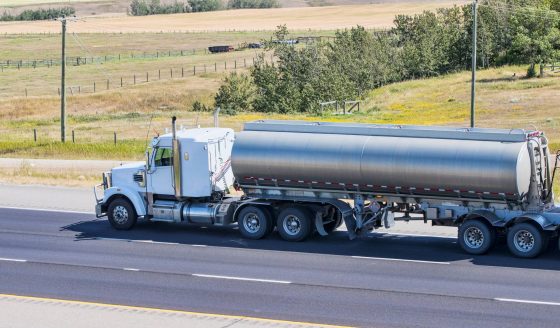Transporting oil, milk, and other liquid cargo can affect a vehicle’s stability and handling, and drivers need to have specific knowledge in order to carry these liquid live loads safely.

Photo credit: gettyimages.ca/Stefonlinton
In November 2021, a worker was driving a tanker truck loaded with salt brine. As the truck descended a hill, it rolled on its side and hit a utility pole. The driver died. Full details of how it happened are still being discovered, through an active investigation.
It’s important for employers and workers to be aware of the particular hazards of transporting liquid live loads. A “live load” is made up of water, milk, or any other type of liquid cargo. As the truck moves, the weight of a liquid live load and the load’s centre of gravity shift. This can make the load “slosh around” from side to side or back and forth.
All drivers of liquid live loads need to be trained so they understand:
- How liquid live loads can affect a vehicle’s stability and handling
- Where to find load capacity information on each vehicle
- How to determine the weight of a load to make sure it doesn’t exceed the gross vehicle weight specified by the manufacturer
More information — for large commercial vehicles and smaller ones like flatbed and pickup trucks — is available in this WorkSafeBC bulletin, Stability and handling hazards of driving trucks and trailers with live loads.
Getting information out ASAP
Nigel Corduff, a supervisor in WorkSafeBC’s Occupational Health and Safety Investigations, told me that WorkSafeBC recognizes that investigations can take a long time, and they wanted to get key information out to workers and employers as soon as they could.
“Just because a person might have a license to drive different kinds of trucks, what you really need is specific training and experience with each,” he says.
The goal of an investigation is to prevent future incidents. Each investigation results in a full report with recommendations. (See more information about what’s involved in WorkSafeBC investigations.)
When I spoke with Nigel, he was in his truck, pulled over en route from an investigation, on his way to a conference in Richmond. He was on his way to tell more than 400 occupational safety officers (and their support staff) about his team’s investigation into a workplace fatality in 2017. A fuel transfer worker had died when gasoline vapours were ignited by a spark from static electricity. In 2021, B.C.’s Occupational Health and Safety Regulation was changed to improve safety for workers in the fuel transfer industry. The updated Regulation includes a requirement that ignition sources need to be eliminated or controlled when combustible fuel is being handled.
“We also changed the legislation related to grounding and bonding when flammable liquids are being transferred,” Nigel says. “It takes a lot of work, but that’s why a lot of my team got into the safety businesses: to move that needle on safety. If you inform everybody, then you know you’ve gone a long way to removing the problem.”
Thank you to Nigel and everyone else working to move the needle on safety.


